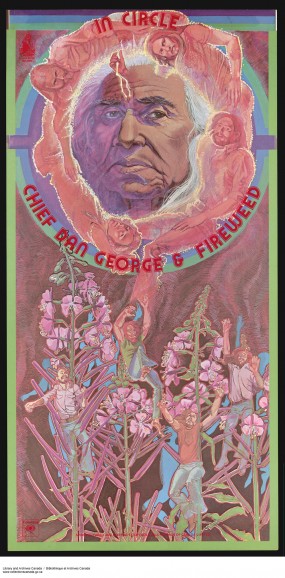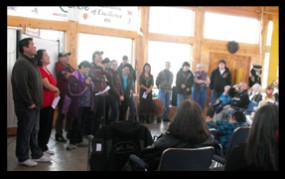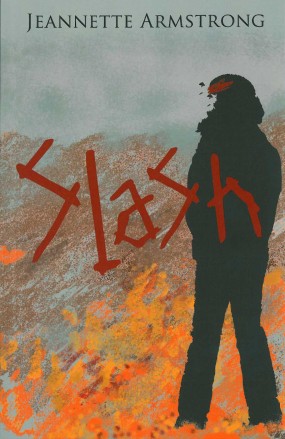
Album cover to In Circle by Chief Dan George and Fireweed (1974). Library and Archives Canada: R11274, e010754591
Following shortly on Chief Dan George’s famous speech, Indigenous writers of fiction, poetry, and non-fiction slowly gained more recognition in Canadian literature. George’s first book, My Heart Soars, was published in 1974. Other writers who emerged during this time were Jeannette C. Armstrong, Beth Brant, Maria Campbell, Beatrice Mosionier (formerly Culleton), Basil H. Johnston, Wayne Keon, Thomas King, Lee Maracle, Daniel David Moses, and Duke Redbird. These writers also engaged with the transcriptions of influential older storytellers, most notably Harry Robinson’s Write It on Your Heart (1989), the first of three volumes of Robinson’s storytelling edited by Wendy Wickwire.
Early anthologies of Indigenous writing, such as Kent Gooderham’s I Am an Indian (1969) and Waubageshig’s The Only Good Indian: Essays by Canadian Indians (1970), also made important contributions to establishing Indigenous writers on the Canadian literary landscape. Other anthologies quickly followed these, like David Day and Marilyn Bowering’s Many Voices: An Anthology of Contemporary Canadian Indian Poetry (1977), as well as Penny Petrone’s important First People, First Voices (1983) and Northern Voices: Inuit Writing in English (1988).
Theytus Books and Pemmican Publications began publishing in 1980 to support the growing numbers of Indigenous writers. Another publisher, Kegedonce Press, was founded in 1993. Together, these make up the three key Indigenous-owned, operated, and focused publishing houses in Canada—presses which “attempt to open up a space for Native literature within the dominant literary institution” (Godard 205).
Many mainstream publishers now publish Indigenous authors as well, but these three publishers provide essential infrastructure to foster and maintain the burgeoning field of Indigenous literatures in Canada.
In 1982, another essential development in literary infrastructure occurred when the Okanagan First Nation founded the En’owkin International School of Writing (now the En’owkin Centre) in affiliation with Okanagan College and the University of Victoria. Jeannette Armstrong became En’owkin’s director in 1986. This important initiative supports, educates, and trains Indigenous creators, such as Richard Van Camp and the Ullus Collective, and is also associated with Theytus Books. In an interview with Canadian Literature, Thomas King states that the En’owkin Centre is important because it
gives Native kids a chance to look at writing as a career in a setting that you know has the accoutrements of being able to do it. But in the end, you’re not going to train writers there. You will encourage writers there. And you will give them a good beginning and whether or not they do anything with it is up to them. (n. pag.)
Origins of an Emerging Literature
While we have discussed some of the key figures and social changes that have been important to the ongoing development of Indigenous literature in Canada, it is impossible to find one point of origin for the explosion in Indigenous literature that began in the 1970s and 1980s. However, we can safely say that there are almost three generations of well-established Indigenous writers in Canada.
Because life writing is not always classified as literature, early works such as Maria Campbell’s Halfbreed (1973), Lee Maracle’s Bobbi Lee: Indian Rebel (1975), Minnie Aodla Freeman’s Life among the Qallunaat (1978), Anthony Apakark Thrasher’s Thrasher … Skid Row Eskimo (1976), and Basil Johnston’s Moose Meat & Wild Rice (1978) have sometimes been overlooked. Fortunately, since the emergence of autobiography studies as a field in Canada, these works are studied in English classrooms (see Egan and Helms 5-6).
In his article Canadian Native Literature and the Sixties: A Historical and Bibliographical Survey,
Hartmut Lutz makes the case that George Clutesi’s Potlatch (1969) is a “multi-media novel” (183–86). As Armand Garnet Ruffo argues in his introduction to An Anthology of Canadian Native Literature (2013), there was “no such thing as Native literature—at least not as it is understood today” in the 1970s (xxi), and “it wasn’t until the late 1980s and early 1990s that contemporary Native literature began to be taken seriously and to make inroads into the consciousness of literary Canada” (xxii-xxiii). Important writers in this literary resurgence or renaissance of Indigenous literature include Jeannette Armstrong (Slash, 1985), Beatrice Culleton (In Search of April Raintree, 1983; critical ed. 1999), Thomas King (Medicine River, 1989), Lee Maracle (Sojourner’s Truth and Other Stories, 1990), and Ruby Slipperjack (Honour the Sun, 1987).
Many of these writers worked hard to set up or consolidate institutions or critical resources for the future. Tomson Highway and Daniel David Moses were closely involved with Native Earth Performing Arts, a drama collective founded in 1982 and still running. Highway’s play The Rez Sisters made waves in Toronto when it opened in 1986. Jeannette Armstrong founded the literary journal, Gatherings: The En’owkin Journal of First North American Peoples (1990–2003). Poet Lenore Keeshig-Tobias worked with the Writers’ Union of Canada to ensure that Indigenous authors were adjudicated by their peers when considered for grants by the Canada Council. Moses co-edited An Anthology of Canadian Native Literature in English (Oxford, 1992) with Terry Goldie, the first major teaching anthology for literature courses and now in its fourth edition. It collected a wide array of writers who had published in less mainstream venues, such as Beth Brant, Rita Joe, Wayne Keon, Alootook Ipellie, and Duke Redbird, as well as introduced new younger writers such as Armand Garnet Ruffo and Drew Hayden Taylor.
Works Cited
- Godard, Barbara.
The Politics of Representation: Some Native Canadian Women Writers.
Canadian Literature 124–25 (1990): 183–225. Print. (PDF) - King, Thomas.
An Interview with Thomas King (August 1999).
By Margery Fee and Sneja Gunew. canlit.ca. Canadian Literature, Aug. 1999. Web. 18 Apr. 2013. (Link) - Lutz, Hartmut.
Canadian Native Literature and the Sixties: A Historical and Bibliographical Survey.
Canadian Literature 152–53 (1997): 167–91. Print. (PDF) - Egan, Susanna, and Helms, Gabriele.
Auto/biography? Yes. But Canadian?
canlit.ca. Canadian Literature, 10 Aug. 2012. Web. 9 Sept. 2013. (PDF) - Ruffo, Armand Garnet.
Introduction.
An Anthology of Canadian Native Literature in English. 4th ed. Ed. Daniel David Moses, Terry Goldie, and Ruffo. Oxford: Oxford UP, 2013. xii–xxxv. Print.










 ©
©